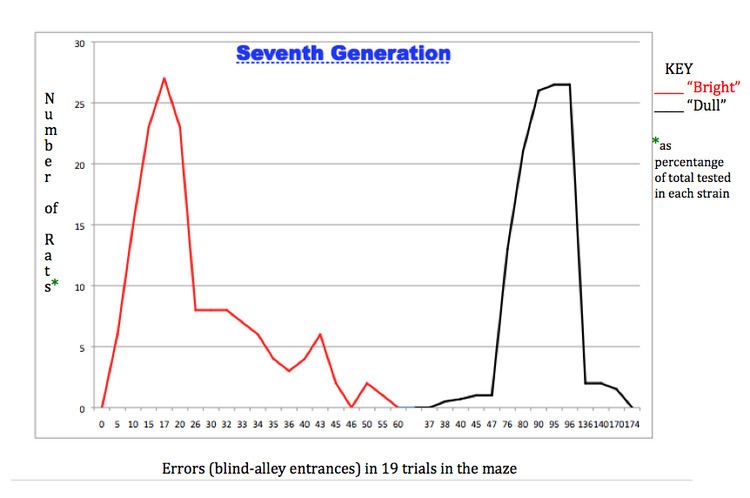 | ||
Tryon's Rat Experiment is a psychology experiment conducted by Robert Tryon.
Contents
Experiment set-up
Prior to Robert Tryon’s study of selective breeding, concluded in 1942, many psychologists believed that environmental, rather than genetic, differences produced individual behavioral variations. Tryon sought to demonstrate that genetic traits often did, in fact, contribute to behavior. To do so, Tryon created an experiment that tested the proficiency of successive generations of rats in completing a maze. He initiated the experiment by exposing a genetically diverse group of rats to the maze, labeling those who made the fewest errors “bright”, and those with the most errors “dull”. Tryon then mated the “bright” males with “bright” females, and “dull” males with “dull” females. After their children matured, Tryon repeated the maze test with them, and again separated the “bright” and the “dull”, again breeding “bright” with “bright” and “dull” with “dull”. Tryon continued this process for seven generations, creating two distinct breeds of “bright” and “dull” rats. In order to demonstrate that behavior had little effect on the genetically selectively bred rats, and lessen the chance of error when making his conclusions, Tryon cross-fostered the rats—that is, he had a “dull” mother raise “bright” children, and vice versa. The independent variables in his experiment were the parental pairings, the choice of environment and parents for upbringing, and number of rats put through the maze. The dependent variable was the number of errors made by the rats in 19 trials of the maze.
Implications and conclusions
While Tryon's results showed that the “bright" rats made significantly fewer errors in the maze than the “dull" rats did, the question exists of what other sensory, motor, motivational, and learning processes also influenced the results of the experiment. A common misconception of this experiment and other similar experiments is that the observed change in the performance in the maze directly correlates with general learning ability. This is not the case. Rather, it has become a widely accepted belief among behavior geneticists that the superiority of the bright rats was confined to Tryon’s specific test; thus, it is not possible to claim that there is a difference in learning capacity between the two groups of rats. Genetic variation, such as better peripheral vision, can make some rats “bright” and others “dull”, but does not determine their intelligence. However, Tryon's well-known rat-maze experiment revealed that the variance in rat performances was due to genetic factors, as their environments were meticulously controlled to be identical.
In 1963, however, Harvard psychologist, Robert Rosenthal realized that there was a major experimental error in Tryon's experimental design. It was not a "blind study". That is, the experimenters working with the rats knew which group was bred to be "maze bright" and which group was bred to be "maze dull". Rosenthal conducted an experiment using "expectation" as the independent variable, instead of breeding.
He had students run rats through a maze that they thought were bred to be "maze bright" and "maze dull" just a Tryon had. However, these rats were randomly assigned to these groups with no breeding. The amazing results show data very similar to Tryon's. The " maze bright rats" ran the maze significantly better than the "maze dull rats" and the graph produced had the same bi-modal distribution.
It was hypothesized that the students had treated the "bright" rats, whom they thought were genetically superior, much more as pets; giving them more attention, encouragement, affection, and the benefit of the doubt. This study began a series of experiments referred to as "the self-fulfulling prophecy". That is, what you expect to see and predict will happen, often will occur.
